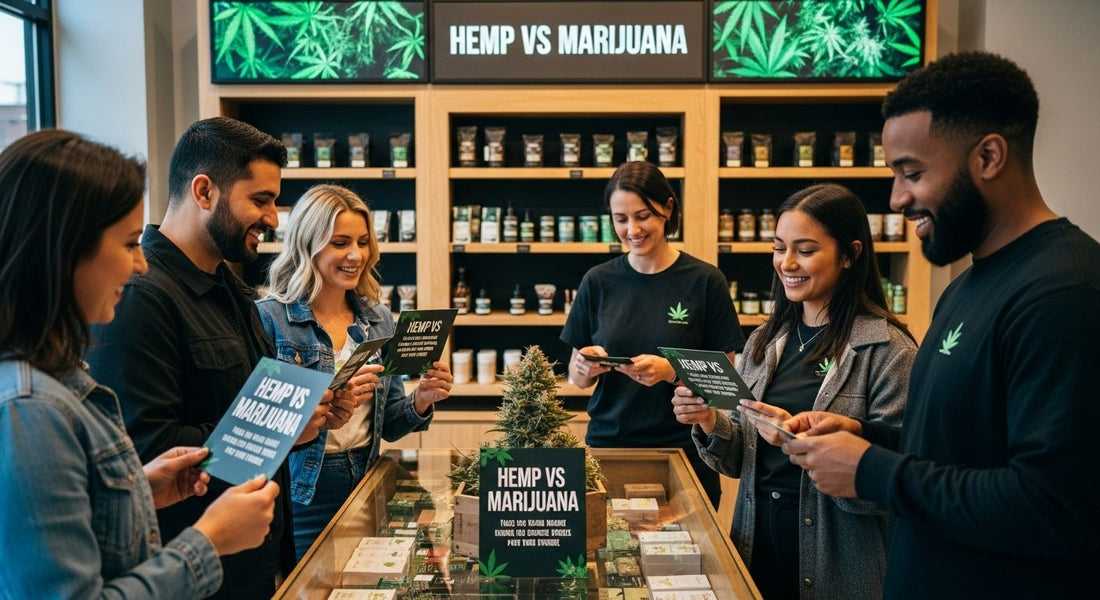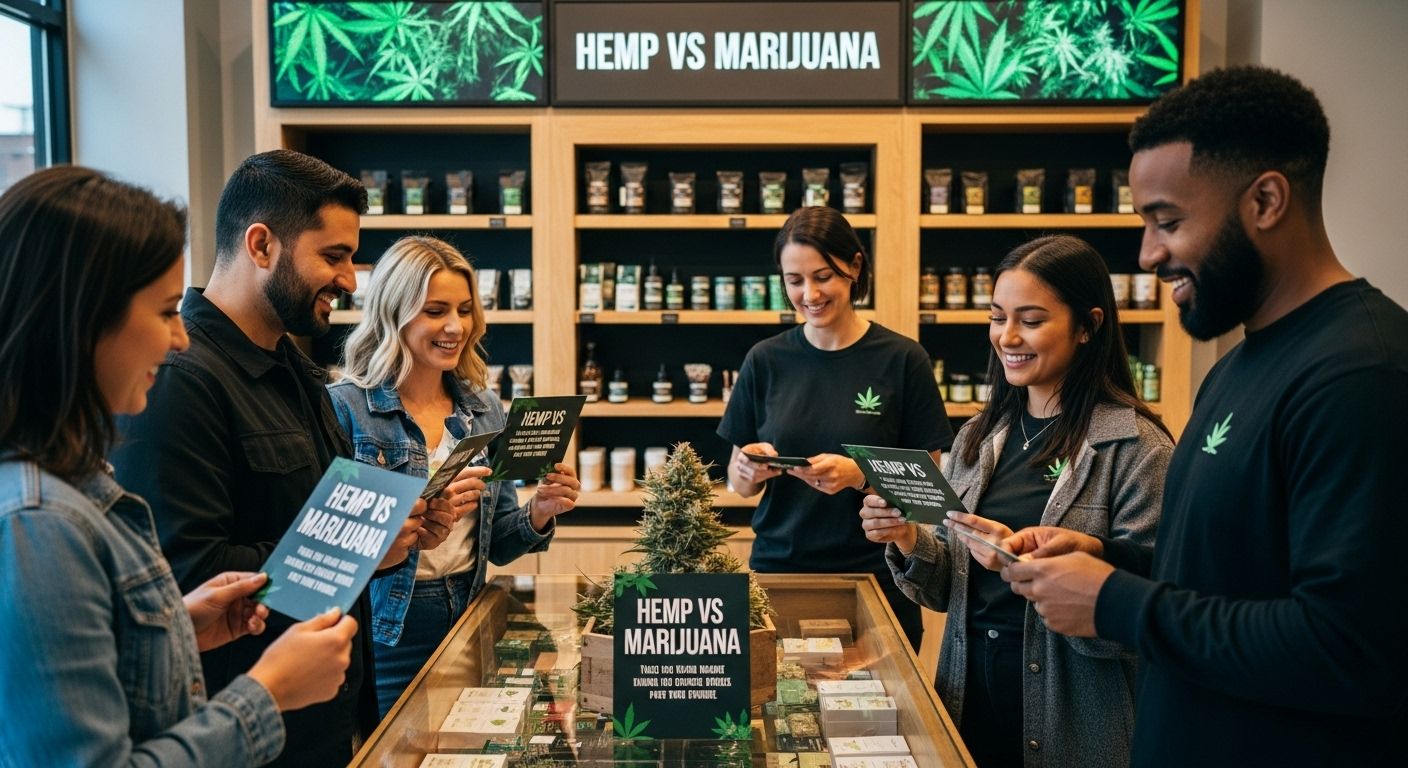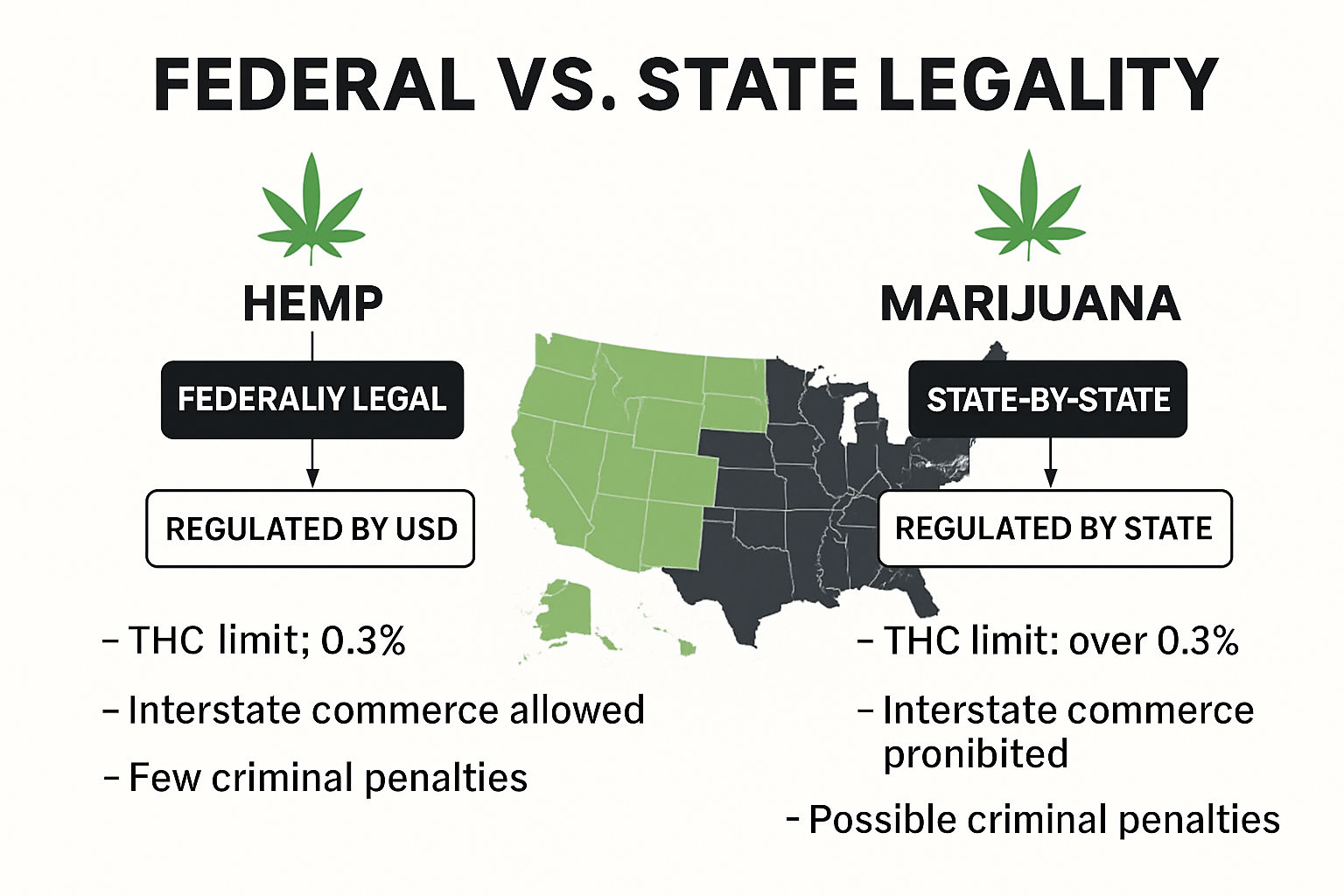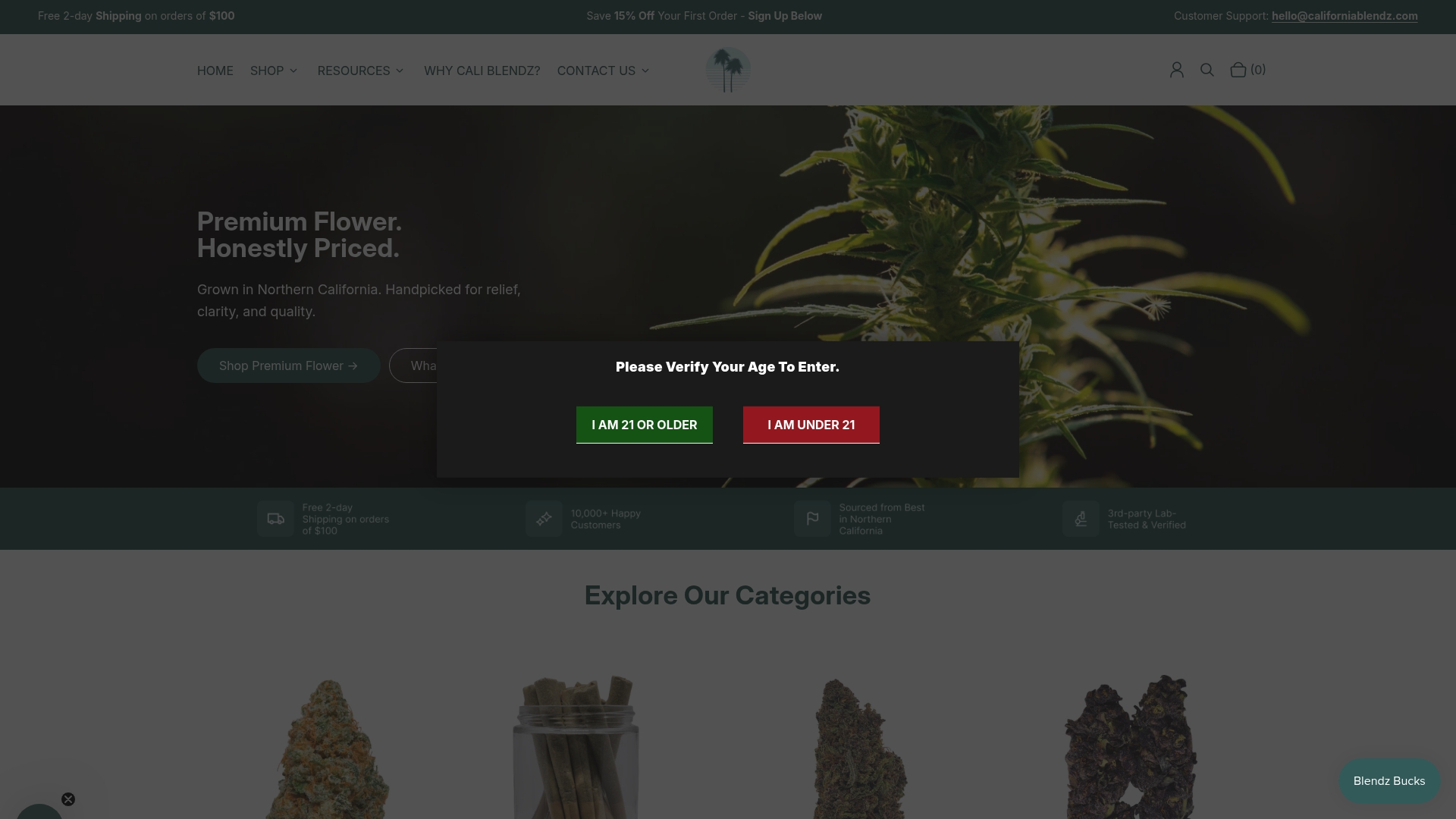Understanding Hemp vs Marijuana Legality: Key Insights
Written by California Blendz

Hemp and marijuana might look nearly identical at first glance, with both coming from the same Cannabis sativa plant. Most people see cannabis as a single controversial topic. But that changes fast when you realize hemp contains less than 0.3 percent THC while marijuana can have up to 35 percent. That tiny chemical difference creates massive gaps in legality, everyday use, and even how these plants reshape entire industries.

Table of Contents
- Differentiating Between Hemp and Marijuana: Definitions and Uses
- The Importance of Legality: Why Hemp and Marijuana Matter
- The Legal Landscape: Understanding State vs Federal Laws
- Impacts on Consumers: What Hemp and Marijuana Mean for You
- Future Perspectives: Evolving Laws and Social Attitudes
Quick Summary
| Takeaway | Explanation |
|---|---|
| Hemp contains less than 0.3% THC | This low THC content means hemp does not produce psychoactive effects, making it safer for general use. |
| Marijuana has higher THC levels | Marijuana typically contains 5% to 35% THC, which can induce psychoactive experiences and is used for medicinal purposes. |
| Hemp is federally legal in the U.S. | Thanks to the 2018 Farm Bill, hemp can be grown and sold across the country, fostering industrial opportunities. |
| Marijuana laws vary by state | The legal status of marijuana differs significantly, with each state having its own regulations and restrictions. |
| Always verify product origins and quality | Consumers should check product labeling, THC content, and third-party lab testing for safety and compliance. |
Differentiating Between Hemp and Marijuana: Definitions and Uses
Hemp and marijuana represent two distinct varieties of the Cannabis sativa plant, each with unique characteristics, legal classifications, and applications. While they share a botanical origin, their chemical composition and usage dramatically differ.
Botanical and Chemical Composition
The primary distinction between hemp and marijuana lies in their tetrahydrocannabinol (THC) content. Research from the FDA defines hemp as Cannabis sativa plants containing no more than 0.3% THC on a dry weight basis. Marijuana, conversely, contains significantly higher THC levels, typically ranging from 5% to 35%, which produces psychoactive effects.
Industrial and Therapeutic Applications
Hemp serves multiple industrial purposes, including textile production, construction materials, biofuel, and nutritional supplements. Its fibers are remarkably versatile, used in clothing, paper, and even building materials. Marijuana, by contrast, is primarily cultivated for medicinal and recreational purposes, targeting specific therapeutic effects or inducing psychoactive experiences.
Legal and Regulatory Landscape
The legal status of hemp and marijuana differs substantially. Following the 2018 Farm Bill, hemp became federally legal in the United States, enabling widespread agricultural and industrial applications. Marijuana remains more complex, with varying state-level regulations. Learn more about hemp regulations to understand the nuanced legal environment surrounding these plants.
Key distinctions include:
- THC Content: Hemp contains <0.3% THC, marijuana contains >5% THC
- Legal Status: Hemp is federally legal, marijuana has restricted access
- Primary Uses: Hemp focuses on industrial and nutritional applications, marijuana on therapeutic and recreational consumption
To help clarify the core differences between hemp and marijuana, the table below compares their key characteristics, uses, and legal status as explained in this article.
| Characteristic | Hemp | Marijuana |
|---|---|---|
| THC Content | Less than 0.3% | 5% to 35% |
| Psychoactive Effects | No | Yes |
| Primary Uses | Industrial (textiles, supplements) | Medicinal & recreational |
| Legal Status (US, Federal) | Federally legal (2018 Farm Bill) | Illegal federally; varies by state |
| Accessibility | Widely accessible | State dependent, restricted |
| Regulatory Oversight | Largely agricultural, less restricted | Highly regulated |
| Typical Product Forms | Fiber, seeds, oils, extracts | Flower, extracts, edibles |
The Importance of Legality: Why Hemp and Marijuana Matter
Legal distinctions between hemp and marijuana profoundly impact economic development, personal freedom, medical research, and industrial innovation. Understanding these nuanced legal frameworks reveals the complex interplay between regulatory policy, scientific advancement, and social progress.
Economic and Industrial Implications
Research from the National Conference of State Legislatures highlights how federal legalization of hemp has transformed agricultural and manufacturing landscapes. Hemp’s legal status enables farmers and businesses to cultivate, process, and distribute products without previous regulatory constraints. This legal recognition opens substantial economic opportunities across multiple sectors, including textiles, construction materials, nutritional supplements, and sustainable technologies.
Medical Research and Healthcare Access
Legal frameworks directly influence medical research and therapeutic applications. The FDA’s regulatory approach to hemp and marijuana significantly impacts scientific exploration and healthcare accessibility. Legal distinctions determine research funding, clinical trial possibilities, and patient treatment options. By creating clear regulatory pathways, legal definitions enable more comprehensive studies into cannabinoid potential, supporting evidence-based medical interventions.
Personal Rights and Social Justice
Learn more about legal hemp considerations to understand broader societal implications. Legal differentiation between hemp and marijuana affects individual rights, criminal justice outcomes, and social equity. The evolving legal landscape reflects changing societal attitudes toward cannabis, challenging historical stigmas and promoting more nuanced, scientific approaches to regulation.
Key legal considerations include:
- Economic Impact: Hemp legalization creates new agricultural and industrial opportunities
- Research Potential: Clear legal definitions enable more comprehensive scientific exploration
- Social Progress: Evolving regulations reflect changing perspectives on cannabis
The Legal Landscape: Understanding State vs Federal Laws
The legal landscape surrounding hemp and marijuana represents a complex, dynamic regulatory environment where federal and state laws frequently intersect and sometimes conflict. Understanding these intricate legal frameworks is crucial for consumers, businesses, and legal professionals navigating cannabis-related activities.

Federal vs State Legal Dynamics
According to federal regulations, marijuana remains classified as a Schedule I controlled substance, creating significant legal complexity. While federal law maintains strict prohibition, individual states have progressively enacted their own cannabis regulations, establishing divergent legal frameworks that challenge traditional federal enforcement approaches. This creates a nuanced legal terrain where compliance requires careful navigation and understanding of both state and federal statutes.
Regulatory Implications for Businesses and Consumers
The disconnect between federal and state laws generates substantial legal uncertainty. Hemp, federally legalized through the 2018 Farm Bill, provides a more straightforward regulatory path. Marijuana, conversely, remains subject to extensive legal restrictions and varying state-level interpretations. Businesses operating in this space must meticulously understand jurisdiction-specific regulations, potential legal risks, and compliance requirements. Explore our detailed guide on hemp legal considerations to better comprehend these complex legal dynamics.
Interstate Commerce and Legal Challenges
The current legal framework presents significant challenges for interstate commerce and transportation of cannabis-related products. State-level variations in cannabis laws create potential legal risks for businesses and individuals moving products across jurisdictional boundaries. Entrepreneurs and consumers must remain vigilant about potential legal complications arising from these regulatory disparities.
Key legal considerations include:
- Federal Primacy: Federal law technically supersedes state cannabis regulations
- State Autonomy: Individual states continue to develop unique cannabis regulatory frameworks
- Ongoing Legal Evolution: Cannabis laws remain dynamic and subject to continuous change
Impacts on Consumers: What Hemp and Marijuana Mean for You
The legal distinctions between hemp and marijuana have profound implications for consumers, affecting everything from personal wellness choices to potential legal risks. Understanding these nuanced differences empowers individuals to make informed decisions about product selection, usage, and potential therapeutic applications.
Personal Health and Wellness Considerations
Research from the National Institute of Justice highlights critical consumer protection challenges in the cannabis market. Hemp-derived products offer wellness benefits without significant psychoactive effects, making them accessible for individuals seeking natural health solutions. Consumers must carefully verify product origins, THC content, and third-party lab testing to ensure safety and legal compliance.
Legal Risk and Personal Responsibility
Navigating the complex legal landscape requires consumers to understand potential consequences. Hemp products containing less than 0.3% THC provide more straightforward legal access, while marijuana-derived products remain subject to significant regulatory restrictions. Explore our comprehensive guide on hemp legal considerations to understand your rights and potential legal implications.

Product Selection and Quality Assurance
Consumers face critical choices when selecting cannabis-related products. Hemp-derived offerings provide broader accessibility, with potential applications in nutrition, wellness, and lifestyle enhancement. Marijuana products, while more regulated, offer targeted therapeutic options. Understanding product composition, intended use, and legal status becomes paramount in making responsible consumption decisions.
Key consumer considerations include:
- Product Verification: Always request and review third-party lab testing results
- Legal Awareness: Understand local and federal regulations before purchasing
- Intended Use: Select products aligned with personal wellness or therapeutic goals
The following table summarizes how the legal distinctions between hemp and marijuana impact various aspects for consumers, from product access to legal risks and use cases.
| Consumer Consideration | Hemp | Marijuana |
|---|---|---|
| Legal Access | Widely accessible federally | Restricted; varies by state |
| THC Content | <0.3% | 5%-35% |
| Psychoactive Risk | None | Yes; psychoactive effects possible |
| Product Verification Need | Lab testing recommended | Lab testing essential, plus compliance checks |
| Intended Use Options | Nutrition, wellness, lifestyle | Therapeutic, recreational |
| Legal Risk | Minimal if compliant | Substantial in non-legal states |
Future Perspectives: Evolving Laws and Social Attitudes
The legal landscape surrounding hemp and marijuana represents a dynamic ecosystem constantly reshaping itself through legislative action, scientific research, and shifting societal perspectives. Understanding these transformative processes provides insight into potential future regulatory developments and cultural acceptance.
Legislative Evolution and Policy Transformation
According to the 2018 Farm Bill, federal recognition of hemp as a distinct agricultural commodity marked a pivotal moment in cannabis policy. Ongoing legislative discussions suggest potential comprehensive federal cannabis reform, with increasing momentum toward comprehensive regulatory frameworks that distinguish between hemp and marijuana based on scientific understanding rather than historical stigmatization.
Scientific Research and Medical Perspectives
Advancing scientific research continues to challenge historical perceptions of cannabis. Medical professionals and researchers are progressively exploring the therapeutic potential of cannabinoids, generating robust evidence that could significantly influence future legal and social attitudes. Explore our insights on cannabis destigmatization to understand the emerging perspectives challenging traditional narratives.
Social Attitudes and Cultural Transformation
Public perception of hemp and marijuana is undergoing substantial transformation. Younger generations demonstrate increasingly nuanced understanding, viewing cannabis through lenses of wellness, personal freedom, and potential therapeutic applications. This generational shift promises continued legal and social evolution, potentially accelerating policy reforms and reducing historical stigmatization.
Key future considerations include:
- Regulatory Flexibility: Anticipate more adaptive legal frameworks
- Scientific Validation: Expect increased research exploring cannabinoid potential
- Social Normalization: Observe continued cultural acceptance and understanding
Experience Legality and Quality with California Blendz
Reading about the legal differences between hemp and marijuana can feel overwhelming, especially when you want safe, reliable products that follow the law. If you value products that are organically grown, lab-tested, and fully compliant with both federal and state guidelines, you are not alone. Many consumers share your concerns about uncertain legality, inconsistent labeling, and the challenge of finding trustworthy sources. That is why California Blendz is dedicated to providing premium hemp-derived products that put legal compliance, transparency, and your peace of mind first.
Explore The Flower Collection for our signature range of carefully curated flowers.

Take control of your wellness by shopping products that combine quality with full legal clarity. Visit California Blendz now to shop confidently and transform your knowledge into a safe, satisfying cannabis experience.
Frequently Asked Questions
What is the main difference between hemp and marijuana?
The primary difference between hemp and marijuana lies in their THC content. Hemp contains less than 0.3% THC, while marijuana typically contains between 5% and 35% THC, which produces psychoactive effects.
Are hemp and marijuana legal in all states?
No, the legal status of hemp and marijuana varies by state. Hemp is federally legal in the U.S. due to the 2018 Farm Bill, whereas marijuana’s legality is more complex, with each state having its own regulations.
What are the industrial uses of hemp?
Hemp is used for a variety of industrial purposes, including textiles, construction materials, biofuel, and nutritional supplements. Its fibers are highly versatile, making it suitable for clothing, paper, and building materials.
How does the legal distinction between hemp and marijuana impact consumers?
The legal distinctions affect consumers’ access to products and potential legal risks. Hemp-derived products are more widely accessible due to lower THC content, while marijuana products are subject to stricter regulations, demanding consumers to understand the implications of their respective laws.
Recommended
- Understanding the Legalities of Getting Pulled Over with Legal Hemp: W – California Blendz
- Hemp vs Marijuana: Understanding the Key Differences – California Blendz
- HHC vs THC: Understanding the Differences, Benefits, and Legality – California Blendz
- How to Find Quality Hemp Flower: A Comprehensive Guide for Buyers – California Blendz








